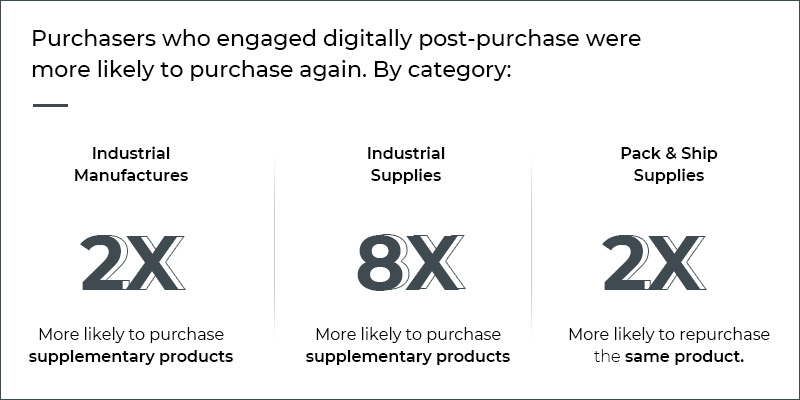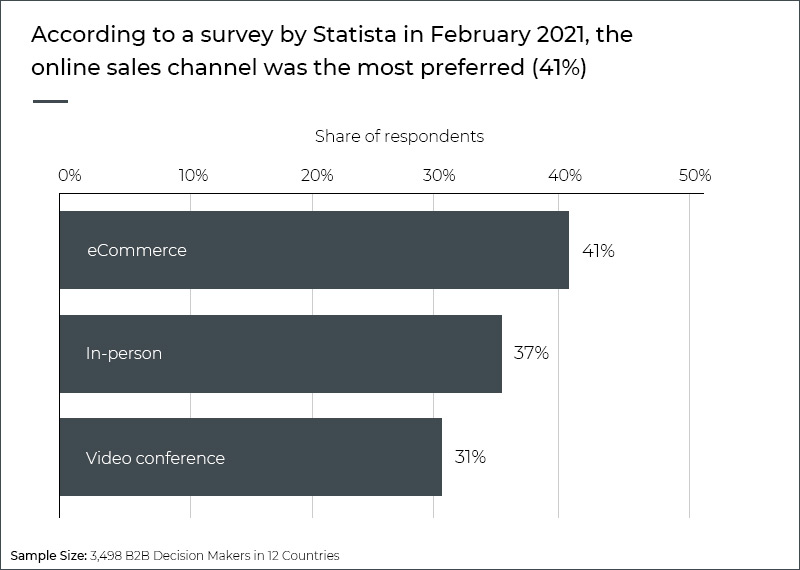The B2B space, which traditionally laid emphasis on customer interaction, had been the slowest to adopt the online sales channel.
But, that has been changing in the last few years. The post-pandemic mandate – Digitization – has further accelerated the shift online and is driving businesses across industries to adopt the online sales channel, creating B2B marketplace opportunities.
It has become an instinctive action for us – to reach out for a device, and browse for requirements online. B2B Commerce is no different – Digital has become the forefront of the initial “search and acquire information phase” in the sales funnel. B2B eCommerce can take it from there and lead prospects to conversions.
According to a Statista survey from September 2021, 26% of B2B buyers made 50% to 74% of their purchases from a B2B eCommerce marketplace. For 10%, the share for online purchases goes up to 75% or more.
Moreover, with B2B eCommerce, the benefits can transcend sales and provide multifaceted business benefits.
In this article, read how B2B marketplace website development can drive a successful business in 2022.
Table of Contents
Reasons Why B2B eCommerce is Booming
A transformative shift gains traction owing to tangible benefits. Technological advancements of the digital age have transformed how commerce is conducted. Businesses at the customer end of B2B transactions have been evolving, sellers without a digital presence are at constant risk of losing customers.
On the other hand, with an online sales channel, they can meet buyers at various stages in the sales funnel and get access to a bigger market, across borders. Additionally, by digitizing business processes they open up opportunities to transform their approach.
To elaborate more on the topic, the benefits of B2B eCommerce that have helped the sector gain traction, are discussed below:
Expands Business Reach
The online channel has been gathering momentum in the B2B space – the likes of eBay, Alibaba have been around since the ’90s! In recent years, Amazon has started its online B2B marketplace by the name of Amazon Business.
This has meant the B2B eCommerce space is gaining traction with businesses considering to source their requirements, creating opportunities for sellers to find their customers on the internet.
With customers online, eCommerce websites can reach out to greater numbers, enhancing the scope of expanding the business reach of a B2B undertaking.
Discussed below are added advantages of a wider customer base:
Easier to conduct business in a niche market: Etsy’s success set an example in the P2P space – how an online marketplace, can be purpose-built to cater to a specific niche.
Taking a cue from Etsy’s success, an increased customer base makes it easier for a B2B marketplace to limit itself to a specific niche and focus on providing customers with tailored solutions to cater to that niche.
Moreover, businesses with an existing offline B2B business can leverage their domain expertise in catering to their customers online.
Build a global brand: With an increased business reach, it is easier to build your brand and enhance its awareness globally.
Better scope to scale: A wider audience also gives an opportunity to scale the business expeditiously.
Enhances Operational Efficiency
Digital enables more connected, data-driven business operations, resulting in benefits such as automation, enhanced efficiency, and opening up opportunities to forge collaborations – both within and outside of the organization.
Business Management Opportunities Outside of the Organization:
Third-party service providers can be partnered with to ease business operations. Many such service providers facilitate APIs that can be integrated with the websites by availing of eCommerce services. The following operations are some examples of possible partnerships:
- Logistics management with shipping fulfillment providers, package tracking information, and others.
- Finance management includes real-time tax information, integrated accounting books, and others.
- Inventory management tools can help businesses manage in-store stock.
- Marketing tools that help in the marketing of the business like automated email service providers, and others
Business Opportunities Within the Organization:
Digitizing operations is augmenting the efficiency of business operations. That further is redefining job roles within organizations. The following aspects evolve by digitizing a B2B business.
Sales – a whole new approach: Evolution might be understating a shift to digitization, it can fundamentally change how organizations approach the sales process.
Traditionally, organizations have employed teams to approach customers. In instances, performance parameters of these teams were subjective, leading to a disjoint work process, something which impacted the client interaction. The customers’ experience with the company was subject to the sales team they interacted with.
The pandemic crisis exposed businesses to the importance of business continuity. Fostering current customer relationships with an emphasis on long-term value has gained traction as an imperative.
B2B eCommerce changes the traditional sales process. The buyer’s first interaction is with the website. The sales teams can now work cohesively to support customer interactions via the website.
Customers get a consistent experience with the organization as a whole rather than segregated autonomous teams.
Consistency further, makes positive customer interaction a repeatable process, enhancing customer experiences and making customer retention easier.
Moreover, digital facilitates easier customer re-engagement. According to research by Google, there are up to 8 times more chances of a returning customer with digital engagement.

eCommerce websites also give businesses the flexibility to tailor the website to achieve these objectives in line with the identified strategies. The buyers can be taken through the entire sales funnel on the website itself or a hybrid approach can be followed wherein the transactions are finalized after the involvement of the sales team, to foster existing business relations.
Customize Your B2B eCommerce Platform to Meet the Desired Business Objectives
Fostering Collaborations: The eCommerce website can be integrated with ERP software systems for businesses to manage their teams internally.
Analytics – Catalyze Success with a Data-driven Approach: eCommerce websites can be integrated with analytics solutions. Data from analytics can catalyze better decision-making and help in formulating better strategies by helping business owners gauge the performance of the sellers and their products based on conversion rates.
eCommerce Means More Opportunities
Innovative business solutions can be provided via the eCommerce platform. For example, consider the following examples:
Offering Products and Services in One Platform: A B2B space that relies on providing services alongside the products can do it on a common platform. For example, installation services, AMCs, and other product-related services that consumers typically need alongside the products can be offered on one purpose-built platform. Consumer businesses can fast-track purchase decisions with the availability of both.
Omnichannel Business Model: Legacy B2B businesses that have an established presence in the industry can use the eCommerce opportunity to extend their offering to the online channel in a way that bridges offline and online commerce.
(This will be discussed in more detail, further in the blog)
B2B with B2C: Businesses such as distributors that have a predominately B2B clientele can open up opportunities to connect directly to the end customers with the online channel.
Difference Between B2B and B2C eCommerce
eCommerce websites let a business reach its customers via the internet. The difference in B2B as opposed to B2C lies in the buying objectives of the customers. The following factors differentiate B2B eCommerce from B2C online sales channels:
- B2B purchase decisions are analysis-driven and rely on the product adding value to the business in the form of better ROI, building the brand, enhancing operational efficiency, and other parameters that benefit the business.
- B2B business transactions can often be of high value. Products are often purchased in bulk.
- Product prices tend to be negotiable and product prices may vary depending upon the quantity. Sellers may want to hide the prices of the products on offer.
- The seller-buyer relationship is lengthier, as consumer businesses will add procured products to their inventory and work towards introducing the same to their customer base. The buyer may want part payments option for high-value transactions.
- With the probability of multiple decision makers and high-value transactions, purchase decisions are extended and may require direct communication between the seller and the buyer.
- Businesses on the customer side are more likely to make repeat purchases than end customers – if the product fits the requirements.
They can be customized to offer functionalities vis-a-vis the business model.
How B2B eCommerce is Changing
B2B is at the focal point for eCommerce in recent times. Evolution in the sector is changing how businesses approach an online business. Discussed below are some of the evolving trends in B2B eCommerce.
Inclusive Features for B2B Marketplaces:
Online retail is present across sectors, this has meant that the decision-makers on the customer side of a B2B transaction have experienced B2C eCommerce individually, their expectations with regard to B2B have risen accordingly.
While this means – greater opportunities for B2B businesses, it also implies that the lines between B2B and B2C eCommerce are blurring. B2B websites can incorporate B2C functionalities and the inclusive shopping experience and offer it on their platform in addition to B2B specific functionalities.
Implementing Creative Business Strategy With the Use of an Online Sales Platform:
As mentioned above, legacy businesses can use an omnichannel approach and utilize both offline and online channels to offer their customers a connected experience.
The online sales channel can be used to provide the initial sales support or as an altogether additional sales channel.
Alternatively, businesses can list their products along with products they provide via dropshipping, in partnership with other businesses on the online platform.
Similarly, businesses that have more than one physical store can offer a connected experience to the buyer with an online B2B marketplace.
Manufacturers have the opportunity to bypass the distribution channel and reach businesses directly on a B2B platform.
Leveraging Technology to Engage B2B Buyers
Organizations are implementing digital solutions to engage the B2B buyer. Tailored CRM software, use of AI chatbots, and other solutions help the buyer in understanding products better, and assist them in making purchase decisions – better, faster.
Importance of Early Adoption to the B2B eCommerce Sector
An online channel may pose newer challenges that businesses adapt once the online channel is established, the businesses can work to further improve and refine their platform by understanding their target market.
Slowly, but steadily, B2B businesses with definitive eCommerce strategies are defining their space with positive customer interactions – online. By continuously working to provide a better platform – they are building a strong foundation in the online space.

Businesses with established legacy presence, which choose to delay their shift to the online channel, run the risk of losing out to these established players.
Popular Business Models of B2B Marketplaces
B2B eCommerce opens a number of ways in which business can be conducted. On a broader level, businesses (sellers) are selling to businesses (buyers), but – depending upon the product, target market, prevailing competition, and the role of the marketplace owner, the marketplace can be structured in a number of ways:
The architecture of the marketplace can be of three types:
Sellers Oriented: eDistribution
Sellers have autonomous control over their online shops within the marketplace. The products, as well as the sellers themselves, can be searched for. The products can be sold directly to the customers and no intermediaries are involved.
Buyer Oriented: eProcurement
Businesses, where the procurement demand is of high value, can attract bidders to simplify the procurement process for themselves. In such scenarios, they need a platform wherein they can post their requirements and invite bids.
B2B marketplaces that allow businesses to post requirements such that sellers can bid for the order are buyer-oriented marketplaces.
Upwork is an example of a buyer-oriented B2B marketplace. On it, businesses post requirements, and service providers bid to provide their services.
Intermediary Oriented Marketplaces
Online marketplaces can also be run by a third-party intermediary company, that invites sellers and buyers to transact on the platform.
-
Another consideration is defining the online marketplace by the products on sale.
Vertical B2B marketplace: The marketplace can cater to an industry niche by selling products from a specific vertical.
Horizontal B2B marketplace: Alternatively, the marketplace can cater to multiple industries.
-
Manufacturers or distributors can broaden the scope of their revenue generation by structuring the eCommerce business on a hybrid business model.
Hybrid marketplaces will cater to both businesses and customers on the platform. In essence, they are an amalgamation of both B2B and B2C.
Although for some businesses, this might not be possible owing to varying target markets, sales cycles, and other factors.
But with the aid of technology, there can be a way around this, the eCommerce platform can be purpose-built to offer a multi-user interface based on the login. Businesses or end-customers will have separate UI with respective product information and supporting features.
-
eCommerce platforms can either have products or services on sale.
But, in the case of products that need services alongside the products and businesses have to avail the same from two separate vendors. It can make good business sense to bring the two on to one platform, and make it easier for buyers to reach out to that single source for their requirements.
How to Set up an Online B2B Marketplace
Considering all the advantages that an online sales channel can bring, and the rise of business opportunities in the B2B space, it can be safe to assume that online B2B eCommerce is a lucrative business option for startups and existing offline businesses alike.
Discussed hereunder are some steps that can help in launching a B2B eCommerce business:
Initial Market Analysis
For startups, this is a crucial step – analyzing the market for potential business solutions that can generate revenue. The idea is to identify a problem and provide a solution to the problem via your eCommerce venture.
For existing businesses though, the business objectives will be in addition to providing solutions. Some of these have been discussed in the sections above. Online sales channels can add revenue, build brand image, achieve operational advantages both within and outside of the organization, and result in other benefits to the business.
With the identified business objectives, a market analysis can be conducted which can provide data to formulate assumptions, which further lead to a hypothesis that would define the requisite features in the website.
Considerations Before Developing the Website
The following steps lay down a path to develop a B2B eCommerce website
Deciding on the Development Method:
eCommerce website development would need time and resources, and the right team with domain expertise to see the project through.
The development of the project could run through significant time till the final website is launched.
Alternatively, a turnkey B2B marketplace solution can be utilized that can fast-track project development, at a significantly lower cost.
The best B2B eCommerce platforms are customizable, scalable, secure, and have been built and backed by result-driven teams.
Plan Financial Aspects:
Depending upon the chosen method, a fair estimate of the time and resources involved can be ascertained.
Prudent allocation of the investment capital towards the development of the website can catalyze future success of the development. Based on available resources, the project development objectives can be devised.
Consider Third-party Alliances
Moreover, third-party service providers ease business processes in eCommerce and let businesses offer transaction experiences similar to established market players like Amazon business, to the buyers.
Deciding on third-party partners and integrating their business APIs will be part of the hypothesis formed after market analysis.
After these decisions have been taken, the next consideration will be testing the hypothesis. The success of the project hinges on giving all stakeholders involved, a B2B marketplace platform that includes the right set of features and functionalities – to provide the right solution to the identified problem.
The ideal approach to achieve that is utilizing an MVP-first approach. Let’s understand what an MVP is and how it will help devise a purpose-driven project development course.
Launch a Purpose-built eCommerce Marketplace with B2B Specific Features
MVP in B2B eCommerce
The hypothesis for an eCommerce business is based on market assumptions. In the real-world scenario, buyers might need features that might not be included in the hypothesis, and those which are – might not be practically useful to them.
This is where developing a Minimum Viable Product first, helps in getting the final product purpose-built according to the needs of the buyer.
An MVP is that version of the product with a minimum set of features that makes it possible to get feedback from the buyers.
MVP can be a milestone in waterfall development.
Alternatively, iterative product development can use an MVP approach to test its riskiest assumption first, and pivot, if required, early in the development phase of the product. So the development process is like ships sailing in the times gone by – setting a target when the journey begins, constantly correcting in due course of the journey.
Additionally, if need be, an MVP will help in getting traction from the investors.
Test Your Business Idea with Minimum Viable Product & Upscale with Each Iteration
Marketing the eCommerce Website
Once the website is launched, the next consideration is marketing the website. Digital marketing channels can give the website the necessary attention and help build brand awareness.
It opens up multiple opportunities to reach out to the target audience, build brand presence, define the niche of the business, and achieve other marketing objectives with better results.
Set realistic, specific goals, relying on metrics to set the marketing machinery in motion with targets to get traffic and convert that traffic into leads.
You may consider the following digital marketing channels:
- Content marketing.
- Social media marketing
- SEO and SEM.
- Promotional collaborations.
And other channels that can bring results in the targeted domain.
To Sum It Up
B2B eCommerce is on the rise, presenting opportunities for businesses to cash in on the shift to digitization. According to Forrester, transactions on B2B platforms in the US alone are expected to be valued at $ 1.8 trillion by 2023, making online sales channels integral to business plans for 2022 and beyond.
Legacy businesses can transform sales channels and their business operations to achieve eCommerce success with a result-driven approach. With a digital presence, they also prepare themselves for a future that promises accelerated digitization and further evolution of the sector.
Startups can analyze the targeted industry and approach with an MVP first market strategy.
In both scenarios, the best B2B Marketplace software can ease eCommerce transition with the flexibility to let businesses approach the shift with a purpose-driven zeal.



